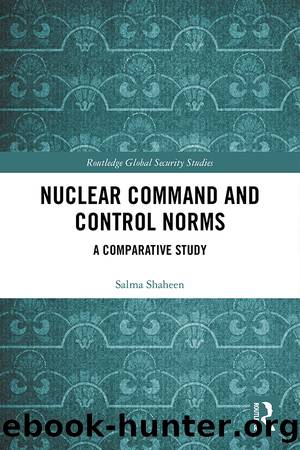Nuclear Command and Control Norms: A Comparative Study by Salma Shaheen

Author:Salma Shaheen [Shaheen, Salma]
Language: eng
Format: epub
Tags: International Relations, Peace, Political Science, Security (National & International), General
ISBN: 9780429790799
Google: MM5wDwAAQBAJ
Goodreads: 40590938
Publisher: Routledge
Published: 2018-09-28T11:42:55+00:00
However, after becoming commander of the SFC, Bhavnani revealed in an interview to defence magazine Force that the Indian air force had been authorised: to control, to select targets and to deliver nuclear weapons (Bhavnani, 2005: pp. 4â5). This highlights the lack of integration of other armed services â army and navy â into the operationalisation of the nuclear policy.
There has been a much discussed and criticised âturf warâ among the three armed forces over the control of nuclear assets, budgetary issues and maintaining serviceâs control over its core competences. Creation of the SFC was deemed as a step towards developing an integrated tri-service approach and attitude; however, it is still struggling âto get the possession of weapon delivery systems, adequate manpower, or even a permanent headquarter, showing a lackadaisical attitude on the part of the government in strengthening the institution of the SFCâ (Pant, 2008: p. 88).
The SFC is headed by a commander-in-chief who is selected from one of the three armed forces on a rotation basis. The SFC, a tri-service command, serves dual functions (Kampani, 2013: pp. 107â109). It is part of the Integrated Defence Headquarters within the Ministry of Defence as well as it works under the Chiefs of Staff Committee whose chairman, being the most senior among the services chiefs, ensures the rotation of strategic forces command among the three services. The SFC is responsible for providing dual services as it reports to both the Executive Council and the chairman of the Chiefs of Staff, which could be confusing during a crisis. The strategic forces commander reporting to the Executive Council would be seen as unsatisfactory from providing a unified input viewpoint, similarly a commander reporting to the chairman of the Chiefs of Staff Committee would also be considered as unsatisfactory from a civilian control perspective (Rana, 2014).
Furthermore, there is no fixed tenure for the commander of SFC that affects continuity in carrying out the operationalisation of nuclear policy. The office of SFC has remained neglected and lacking in professional acumen. Four commanders-in-chief in six years depicts the lack of consideration and seriousness the NCA attached to the post of SFC. One of these four commanders, after serving the SFC, moved to a senior position in his service (Rana, 2014). This implies a lack of commitment to the post, with senior military officers seemingly more concerned about their promotions and associated benefits, with the SFC office never having been an attractive career choice for a senior military officer.
Many Indian scholars and official committees (notably the Arun Singh Committee on Defence Expenditure 1990 and the Naresh Chandra Committee on National Security) had proposed that there should be single unified command under which tri-service command of the SFC should work (Standing Committee on Defence, 1994: p. 13). A common recommendation made by scholars and committees is to appoint the Chief of Defence Staff (CDS), like in the United Kingdom, who can provide single-point advice to the government on strategic matters. For instance, the Arun Singh Committee in 1990
Download
This site does not store any files on its server. We only index and link to content provided by other sites. Please contact the content providers to delete copyright contents if any and email us, we'll remove relevant links or contents immediately.
What's Done in Darkness by Kayla Perrin(25521)
Shot Through the Heart: DI Grace Fisher 2 by Isabelle Grey(18239)
Shot Through the Heart by Mercy Celeste(18183)
The Fifty Shades Trilogy & Grey by E L James(17794)
The 3rd Cycle of the Betrayed Series Collection: Extremely Controversial Historical Thrillers (Betrayed Series Boxed set) by McCray Carolyn(13208)
The Subtle Art of Not Giving a F*ck by Mark Manson(12939)
Scorched Earth by Nick Kyme(11862)
Stepbrother Stories 2 - 21 Taboo Story Collection (Brother Sister Stepbrother Stepsister Taboo Pseudo Incest Family Virgin Creampie Pregnant Forced Pregnancy Breeding) by Roxi Harding(11088)
Drei Generationen auf dem Jakobsweg by Stein Pia(10236)
Suna by Ziefle Pia(10197)
Scythe by Neal Shusterman(9291)
International Relations from the Global South; Worlds of Difference; First Edition by Arlene B. Tickner & Karen Smith(8645)
Successful Proposal Strategies for Small Businesses: Using Knowledge Management ot Win Govenment, Private Sector, and International Contracts 3rd Edition by Robert Frey(8445)
This is Going to Hurt by Adam Kay(7726)
Dirty Filthy Fix: A Fixed Trilogy Novella by Laurelin Paige(6471)
He Loves Me...KNOT by RC Boldt(5824)
How to Make Love to a Negro Without Getting Tired by Dany LaFerrière(5416)
Interdimensional Brothel by F4U(5324)
Thankful For Her by Alexa Riley(5192)
